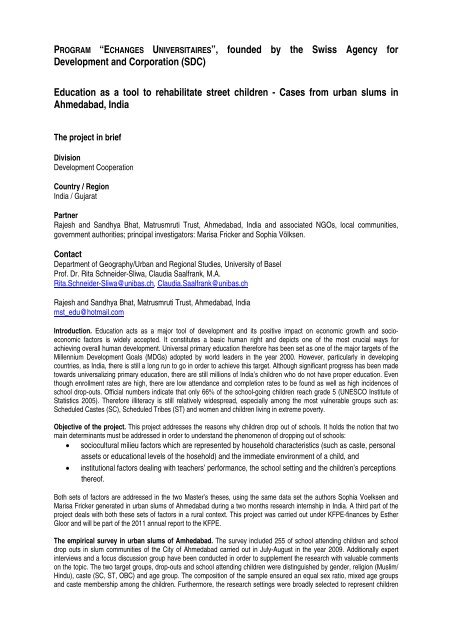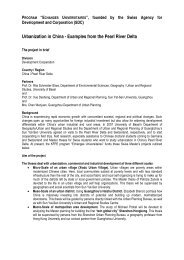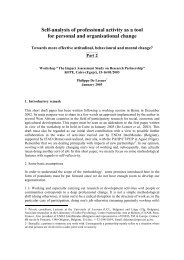Household structures, personal assets and socio-cultural ... - KFPE
Household structures, personal assets and socio-cultural ... - KFPE
Household structures, personal assets and socio-cultural ... - KFPE
Create successful ePaper yourself
Turn your PDF publications into a flip-book with our unique Google optimized e-Paper software.
PROGRAM “ECHANGES UNIVERSITAIRES”, founded by the Swiss Agency for<br />
Development <strong>and</strong> Corporation (SDC)<br />
Education as a tool to rehabilitate street children - Cases from urban slums in<br />
Ahmedabad, India<br />
The project in brief<br />
Division<br />
Development Cooperation<br />
Country / Region<br />
India / Gujarat<br />
Partner<br />
Rajesh <strong>and</strong> S<strong>and</strong>hya Bhat, Matrusmruti Trust, Ahmedabad, India <strong>and</strong> associated NGOs, local communities,<br />
government authorities; principal investigators: Marisa Fricker <strong>and</strong> Sophia Völksen.<br />
Contact<br />
Department of Geography/Urban <strong>and</strong> Regional Studies, University of Basel<br />
Prof. Dr. Rita Schneider-Sliwa, Claudia Saalfrank, M.A.<br />
Rita.Schneider-Sliwa@unibas.ch, Claudia.Saalfrank@unibas.ch<br />
Rajesh <strong>and</strong> S<strong>and</strong>hya Bhat, Matrusmruti Trust, Ahmedabad, India<br />
mst_edu@hotmail.com<br />
Introduction. Education acts as a major tool of development <strong>and</strong> its positive impact on economic growth <strong>and</strong> <strong>socio</strong>economic<br />
factors is widely accepted. It constitutes a basic human right <strong>and</strong> depicts one of the most crucial ways for<br />
achieving overall human development. Universal primary education therefore has been set as one of the major targets of the<br />
Millennium Development Goals (MDGs) adopted by world leaders in the year 2000. However, particularly in developing<br />
countries, as India, there is still a long run to go in order to achieve this target. Although significant progress has been made<br />
towards universalizing primary education, there are still millions of India’s children who do not have proper education. Even<br />
though enrollment rates are high, there are low attendance <strong>and</strong> completion rates to be found as well as high incidences of<br />
school drop-outs. Official numbers indicate that only 66% of the school-going children reach grade 5 (UNESCO Institute of<br />
Statistics 2005). Therefore illiteracy is still relatively widespread, especially among the most vulnerable groups such as:<br />
Scheduled Castes (SC), Scheduled Tribes (ST) <strong>and</strong> women <strong>and</strong> children living in extreme poverty.<br />
Objective of the project. This project addresses the reasons why children drop out of schools. It holds the notion that two<br />
main determinants must be addressed in order to underst<strong>and</strong> the phenomenon of dropping out of schools:<br />
• <strong>socio</strong><strong>cultural</strong> milieu factors which are represented by household characteristics (such as caste, <strong>personal</strong><br />
<strong>assets</strong> or educational levels of the hosehold) <strong>and</strong> the immediate environment of a child, <strong>and</strong><br />
• institutional factors dealing with teachers’ performance, the school setting <strong>and</strong> the children’s perceptions<br />
thereof.<br />
Both sets of factors are addressed in the two Master’s theses, using the same data set the authors Sophia Voelksen <strong>and</strong><br />
Marisa Fricker generated in urban slums of Ahmedabad during a two months research internship in India. A third part of the<br />
project deals with both these sets of factors in a rural context. This project was carried out under <strong>KFPE</strong>-finances by Esther<br />
Gloor <strong>and</strong> will be part of the 2011 annual report to the <strong>KFPE</strong>.<br />
The empirical survey in urban slums of Amhedabad. The survey included 255 of school attending children <strong>and</strong> school<br />
drop outs in slum communities of the City of Ahmedabad carried out in July-August in the year 2009. Additionally expert<br />
interviews <strong>and</strong> a focus discussion group have been conducted in order to supplement the research with valuable comments<br />
on the topic. The two target groups, drop-outs <strong>and</strong> school attending children were distinguished by gender, religion (Muslim/<br />
Hindu), caste (SC, ST, OBC) <strong>and</strong> age group. The composition of the sample ensured an equal sex ratio, mixed age groups<br />
<strong>and</strong> caste membership among the children. Furthermore, the research settings were broadly selected to represent children
from different religious groups (Hindu <strong>and</strong> Muslim) <strong>and</strong> children from different backgrounds (orphans, street children, working<br />
children <strong>and</strong> others). Regarding the educational institutions visited, government, private as well as institutions for disabled<br />
children have been taken into consideration.<br />
Theoretical embedding. A core part of the theoretically-based analysis in the MA thesis of Sophia Völksen is the concept of<br />
sustainable livelihoods (Chambers 1989, Bohle 2007). According to this approach, the vulnerability of children towards<br />
dropping out of primary school was examined on the basis of livelihood <strong>assets</strong>, the immediate environment <strong>and</strong> wider<br />
society. With regard to the second MA thesis of Marisa Fricker the capital theory of Pierre Bourdieu as well as theories on<br />
the reproduction of social inequalities through the school system were of particular importance.<br />
Figure 1 Authors conducting fieldwork in Ahmedabad, India<br />
<strong>Household</strong> <strong>structures</strong>, <strong>personal</strong> <strong>assets</strong> <strong>and</strong> <strong>socio</strong>-<strong>cultural</strong> aspects as determinants<br />
of school drop-out rates. Cases from Urban slums in Ahmedabad, India.<br />
Master’s thesis, Sophia Völksen<br />
Objective <strong>and</strong> conceptual background. The study holds the notion that the phenomenon of dropping out of primary school<br />
is related to biography-related factors <strong>and</strong> to family-related structural factors in connection with the particular <strong>cultural</strong> <strong>and</strong><br />
social milieu. This phenomenon is examined based on the <strong>structures</strong> of the joint household the child lives in <strong>and</strong> through the<br />
given, structural, individual (i.e. biographical) characteristics of the child (such as gender, caste, religious affiliation) analyzed<br />
against the backdrop of the child’s larger surroundings (e.g. community, society). Because the Indian context involves<br />
several specific <strong>cultural</strong> features, such as the caste system <strong>and</strong> prevailing gender perceptions, these subjects call for more<br />
detailed investigation.<br />
Key research questions. Core dimensions of the study with corresponding research questions were the following:<br />
• Immediate environment of the child. The household <strong>and</strong> its (structural) <strong>assets</strong>: Do household <strong>assets</strong> show<br />
influence on the risk of school drop-out? What structural <strong>assets</strong> play a crucial role in securing sustainable<br />
livelihoods?<br />
• Background of family members. The immediate social surroundings of the child have great impact on<br />
childhood development: How far is the impact of the educational <strong>and</strong> occupational background of the<br />
parents/gr<strong>and</strong>parents on the child’s vulnerability to drop-out of school? What relations can be observed <strong>and</strong><br />
how can they be interpreted?<br />
• Cultural <strong>and</strong> social factors. Prevailing social <strong>structures</strong> in interrelation with biography-related factors of the<br />
child. This dimension is foremost analyzed along three prevailing <strong>socio</strong>-<strong>cultural</strong> phenomena of Indian society:<br />
gender perceptions, religious affiliation <strong>and</strong> caste membership. Key questions are: Is there a gender bias<br />
regarding education to be found? Does religious affiliation have an impact on school drop-out? Does caste<br />
membership increase the vulnerability of children regarding school drop-out?<br />
Findings. The findings of the study presented below are highly context specific. Therefore, results are not to be taken as<br />
general statements. The results presented are valid only against the backdrop of selected slum communities of Ahmedabad<br />
City. The findings of the study can be summarized as followed:
Background of family members<br />
<strong>Household</strong> structure <strong>and</strong> family <strong>assets</strong>. The study clearly shows that household <strong>structures</strong>, such as the type of housing,<br />
the availability of basic facilities <strong>and</strong> the living space differ considerably between school drop-outs <strong>and</strong> school attending<br />
children. School drop-outs are clearly more likely to live in small size <strong>and</strong> unstable housing <strong>structures</strong> without access to basic<br />
facilities. School attending children however, indicate relatively better living conditions. Therefore, it may be assumed that<br />
children coming from considerably poor households are more likely to drop-out of school than children from households that<br />
are marginally better off. Although there exists a free primary education system, economic restrictions may be a reason for<br />
parents not being able to send their child to school or to ensure successful schooling.<br />
Parental education <strong>and</strong> occupation. The study reveals that the education level of the parents has greater influence on the<br />
child’s risk of school drop-out than the status of occupation. Of particular importance is the education of the mother. Literate<br />
mothers have fewer children, better occupation opportunities, <strong>and</strong> live under better living conditions than illiterate mothers.<br />
Moreover, literate mothers are more likely to send their child to school <strong>and</strong> to provide better nutrition. Hence, educated<br />
mothers play a key role in ensuring a secure <strong>and</strong> sustainable childhood for their children. The father however, plays a greater<br />
role regarding the occupation status. As the father constitutes in the majority of cases the main bread winner his occupation<br />
status has greater influence than the one of the mother. If the father pursues regular paid work this enables the household to<br />
live under better living conditions <strong>and</strong> decreases the risk of school drop-out for the child.<br />
Socio-<strong>cultural</strong> factors<br />
Gender. Regarding the sex of the child, girls face disadvantages in terms of education. Although the sample of the study<br />
pursued gender balance, there are differences to make out between girls <strong>and</strong> boys. Hence, girls are more likely to drop-out<br />
of school once ore multiple times. Furthermore, girls have more siblings <strong>and</strong> therefore may be more likely to miss out on<br />
education due to selective attitudes of the parents generally in favor of boys. Regarding household chores such as care<br />
taking for the sibling(s), boys indicate less regularity as well as fewer hours than girls. Particularly female school drop-outs<br />
are taking care for their siblings long hours daily. However, boys show a higher likeliness to pursue economic activities <strong>and</strong><br />
work in average for longer hours than girls. Furthermore, parents living in poor housing <strong>structures</strong> are more likely to have<br />
boys than girls. This may mean that among very poor families with low living st<strong>and</strong>ard gender preferences are emphasized<br />
even stronger.<br />
Caste membership. The study sample foremost includes children belonging to the so called ‘lower castes’. Therefore,<br />
general statements on disadvantages as a result of caste membership cannot be made. However, for those castes which<br />
have been investigated different distribution pattern become evident. The study shows that children belonging to Denotified<br />
Tribes (DNT), Other Backward Castes (OBC) or Social <strong>and</strong> Education Backward Castes (SEBC) are most prone to droppingout<br />
of school. Children belonging to these castes indicate as well the highest frequency among poor housing <strong>structures</strong>. ST’s<br />
<strong>and</strong> SC’s, Muslims <strong>and</strong> upper caste children show generally better living conditions, have fewer siblings <strong>and</strong> if they are<br />
working, they work for fewer hours. Therefore, it can be assumed that children of DNT, OBC or SEBC membership are<br />
socially disadvantaged which may increase the risk dropping out at the primary school level.<br />
Religious affiliation. The sample showed a balanced representation of Muslim children attending school <strong>and</strong> Muslim school<br />
drop outs. Therefore, religious affiliation does not emerge as a statistically significant variable. However, Muslim girls appear<br />
to be disadvantaged in educational terms compared to Hindu girls, as shown in a sex-biased ratio of school drop outs.<br />
Higher drop out rates of Muslim girls appears to reflect a traditional female role model that prevails in Muslim communities.<br />
Conclusions<br />
The examination of household <strong>structures</strong>, <strong>personal</strong> <strong>assets</strong> <strong>and</strong> <strong>socio</strong>-<strong>cultural</strong> factors in relation with school drop-out does not<br />
allow clear conclusions, yet some trends emerge. First of all, the study makes clear that there exist a multitude of factors<br />
influencing a child’s risk of dropping out of schools. Second, in order to find out more about significant correlations a higher<br />
number of respondents need to be addressed. Therefore, this study allows making assumptions only about possible factors<br />
influencing school drop-out rates in the given context of Ahmedabad City. However, the study shows clearly, that the<br />
educational background of the parents, foremost of the mother, plays a key role for more successful educational biographies<br />
of children. Although the economic situation of the household has considerable influence also, it may be concluded, that<br />
prevailing <strong>socio</strong>-<strong>cultural</strong> phenomena play a major role for the child’s schooling opportunities too. The social construct of<br />
gender, leads to severe discrimination towards the girl child. Furthermore, the hierarchical caste system still means that<br />
children of certain caste membership (such as DNT, OBC, SEBC) face deprivation in daily life. Particularly in the context of<br />
Ahmedabad City special attention must be paid to the strict constraints religious affiliation may mean. Muslims constitute a<br />
minority which lives, due to recurrent violent clashes between Hindus <strong>and</strong> Muslims, under unsecure living conditions. Thus,<br />
the Muslim population lives clearly socially excluded from the Hindu majority. In particular Muslim girls are hindered to move<br />
freely out of their community. Thus, it can be assumed that prevailing unequal conditions pose major restrictions to the<br />
overall childhood educational development <strong>and</strong> schooling of Muslim children.
Children`s school performance <strong>and</strong> perceptions on schools as determinants of<br />
school drop-out rates. A comparison of school attending children <strong>and</strong> school<br />
drop-outs in urban slums of Ahmedabad.<br />
Master`s Thesis, Marisa Fricker<br />
Objective of the study<br />
This study analysed children`s school performance <strong>and</strong> their perceptions on teachers <strong>and</strong> schools using both school<br />
attending children <strong>and</strong> school drop-outs. The study is conceptualized entirely on the perspective of the child. Although<br />
children might still be limited in terms of decision power <strong>and</strong> their agency might be influenced <strong>and</strong> constrained by a number<br />
of factors <strong>and</strong> actors, they still represent the most important actor regarding their schooling <strong>and</strong> educational biographies. The<br />
study, therefore, investigated the children`s perceptions regarding:<br />
• The physical <strong>and</strong> institutional access to schools<br />
• The provision of infrastructure <strong>and</strong> services at schools<br />
• The general attractiveness of schools<br />
• The attractiveness of school material <strong>and</strong> school lessons<br />
• The teacher`s performance <strong>and</strong> pedagogical practices at schools<br />
Concerning the schooling habits of drop-outs <strong>and</strong> school attending children the following conceptual factors were<br />
investigated:<br />
• The children`s own school performance<br />
• The children`s regularity at schools<br />
• The economic activities of the children in relation to their school attendance <strong>and</strong> performance<br />
• The children`s diligence with their homework<br />
• The children`s learning environment at home<br />
With regard to the impact of the schooling institutions the following dimensions were explored:<br />
• The children`s awareness for the importance <strong>and</strong> perceived impact <strong>and</strong> relevance of education<br />
• The drop-outs readiness to return to school<br />
• The motivation to continue with higher education<br />
Selected findings<br />
School environment <strong>and</strong> institutional factors<br />
Accessibility of schools. Results show that the physical accessibility of schools was generally satisfying. It can therefore<br />
be assumed that the spatial distribution of primary schools is only of minor relevance to the phenomenon of school drop-out<br />
in Ahmedabad. However, it has to be emphasized that if the daily trip to school was perceived as potentially risky (major<br />
roads, need to cross insecure areas) this could represent a substantial reason for parents to withdraw their children from<br />
school, particularly in the case of girls. The institutional accessibility of schools proved to be more problematic than their<br />
physical accessibility. The lack of official certificates (birth or school leaving certificate) represented a major obstacle for<br />
some of the children to enroll in schools, which in some cases resulted even in the denial to education.<br />
Infrastructure <strong>and</strong> service provision. The study showed that non-availability of school infrastructure represents a minor<br />
problem in urban Ahmedabad. Only a very small percentage of the schools visited by the interviewees showed serious<br />
deficits. Improvements could be pursued regarding the equipment with libraries <strong>and</strong> the provision of extra tuition.<br />
Teaching <strong>and</strong> tteachers’ absenteeism. The reported class sizes of the children were relatively high, with a median of<br />
approximately 42 pupils per teacher. In extreme cases the pupil-teacher ratios amounted up to 1:100 <strong>and</strong> more pupils. It is<br />
needless to say that classes of this size represent very unfavorable learning environments for young pupils. Another teacherrelated<br />
problem that could be identified through the study was the relatively high rate of teacher absenteeism in the case of<br />
the drop-outs. Concomitantly, the performance of teachers was perceived considerably less satisfying by the drop-outs.<br />
Especially the boys <strong>and</strong> drop-outs that left school at the beginning of the school cycle had a negative image of their teachers.<br />
Considering that some of them were exposed to corporal punishment by their teachers this does not come as a surprise.<br />
Attractiveness of schools, textbooks <strong>and</strong> school lessons. For all of the just mentioned factors a similar pattern emerged<br />
during the empirical analysis. Early drop-outs (lower primary) generally rated textbooks, school lessons <strong>and</strong> the school itself<br />
considerably lower than the rest of the sample. The attractiveness of schools was closely interrelated to the availability of<br />
infrastructure <strong>and</strong> the children`s satisfaction with the performance of the teacher.
Government vs. private schools. Beneficiaries of private schooling predominantly derived from economically stronger <strong>and</strong><br />
better educated homes. Additionally Muslims <strong>and</strong> children from higher strata in the caste hierarchy were disproportionally<br />
overrepresented. Qualitative differences compared to government schools could be discarded with regard to the regularity of<br />
teachers <strong>and</strong> a greater satisfaction level of the children in terms of the school <strong>and</strong> the school lessons. Children of private<br />
schools further appeared to be more motivated <strong>and</strong> showed a higher level of awareness for the relevance <strong>and</strong> importance of<br />
education. However, concerning class sizes private schools presented an even more devastating picture than government<br />
schools.<br />
Child’s performance in schools<br />
Learning attainments of drop-outs vs. school attending children. Both, drop-outs as well as school-going children<br />
pursued some kind of economic activities besides their schooling. This finding demonstrates that schooling <strong>and</strong> work are not<br />
necessarily exclusive choices. Nevertheless drop-outs were three times as likely to be engaged in economic activities <strong>and</strong><br />
showed considerably longer working hours than their school attending counterparts. This suggests that the drop-outs<br />
economic activities might have negatively affected their school career. Although no direct influence of the economic<br />
engagement on children`s performance could be established, work clearly affected the children`s school attendance <strong>and</strong> the<br />
regularity, with which they accomplished their homework. By trend drop-outs were less regular in classes, skipped homework<br />
more frequently <strong>and</strong> showed poorer attainment levels than school attending children. The performance of the children was<br />
further highly related to their satisfaction with the teacher.<br />
Learning environment, emotional <strong>and</strong> intellectual support of the parents. Children of uneducated or little educated<br />
parents proved to be more prone to dropping out. Especially the educational background of the mother appeared to be highly<br />
significant for school survival. For the largest amount of the children (<strong>and</strong> particularly for girls) the mother was the central<br />
person to provide them with (intellectual) <strong>and</strong> emotional support. A lot of the drop-outs were disadvantaged with regard to<br />
their parents’ ability to assist them with their homework <strong>and</strong> their learning environment at home. Illiterate or little educated<br />
parents were less willing to support their children in higher education, especially in the case of girls.<br />
Attitudes <strong>and</strong> aspirations<br />
Perceived relevance, usefulness <strong>and</strong> importance of education. Drop-outs <strong>and</strong> particularly boys clearly perceived<br />
education to be less relevant, useful <strong>and</strong> important than the rest of the interviewees. Their negative attitude towards<br />
schooling could thereby represent either a cause or a consequence of the drop out. Illiteracy, even after several years of<br />
schooling, was one of the major reasons why education was perceived useless <strong>and</strong> inappropriate.<br />
Future aspirations <strong>and</strong> ambitions. Roughly three out of four drop-outs regretted their school leaving <strong>and</strong> would like to reenroll.<br />
Many of them were dissatisfied with their present situation <strong>and</strong> shared a feeling of exclusion <strong>and</strong> deprivation. Only<br />
those drop-outs who have found a satisfying job or associated negative experience with the school ruled out a possible<br />
return to the education system. Many of the drop-outs had no idea with reference to their future occupation. The teacher <strong>and</strong><br />
doctor profession were most popular among those who possessed tangible ambitions. As opposed to school attending<br />
children who pursued to execute jobs which require higher education, drop-outs were more likely to seek after a job<br />
dem<strong>and</strong>ing no or only rudimentary schooling.<br />
Conclusion<br />
With enrolment rates amounting close to 100% in India, educational opportunities have tremendously exp<strong>and</strong>ed over the<br />
past years <strong>and</strong> educational inequalities have disappeared at first sight. Considering the low survival rates <strong>and</strong><br />
disproportionate success of some sections of the society, inequalities have however persisted beneath the surface. This<br />
study shows that especially first generation learners struggle to complete the full cycle of primary schooling. They are<br />
confronted with worse starting conditions <strong>and</strong> lack emotional <strong>and</strong> intellectual support from home. The primary schools show<br />
little success in bridging the distance between the students home <strong>and</strong> school culture <strong>and</strong> fail to reduce these students’<br />
deficits. Low levels of attainment, which are themselves related to low attendance rates, have therefore pushed a rather<br />
significant amount of pupils out of school. Another share has simply lost interest in school <strong>and</strong> does not believe anymore in<br />
the importance <strong>and</strong> relevance of education. Drop-out rates have proved to be highly related to institutional parameters. The<br />
significance of access <strong>and</strong> infrastructure related factors in this particular urban setting could be reduced in the past. Yet<br />
teaching quality <strong>and</strong> the attractiveness of the curriculum <strong>and</strong> the school continue to exercise tremendous influence on young<br />
pupils’ school behaviour <strong>and</strong> attitudes. With respect to the increasing fragmentation <strong>and</strong> privatization of the urban education<br />
sector it could furthermore be concluded that private schools contribute to the perpetuation of inequalities with regard to two<br />
aspects. First, through their conditions of access which clearly favour already privileged sections of society. And second<br />
through the enhanced quality of education they provide in comparison to government schools, whereby this aspect was less<br />
pronounced. The study has insofar demonstrated that while education could imply the promised social upward mobility for<br />
some, for other this promise does not materialize. Already before they have only completed the most elementary schooling,<br />
they drop out of the system. Without guaranteeing access to good quality education adequate to the specific circumstances<br />
of many first generation learners, there is a high risk that social inequalities will be reproduced exactly through the education<br />
system.





